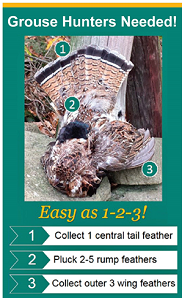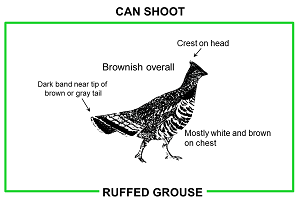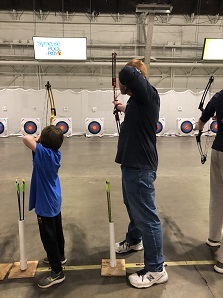Drivers Urged to Be Alert for Moose in the Adirondacks
Early fall is the breeding season for moose in northern New York. During this time moose are wandering looking for mates, leading them to areas where they are not typically seen. While this improves the opportunities for people to enjoy sightings of a moose, it also increases the danger of colliding with one on the roadway.
 Moose are most active at dawn and dusk, which are times of poor visibility. Moose are especially difficult to see at night because of their dark brown to black coloring and their height - which puts their head and much of their body above vehicle headlights. Moose are most active at dawn and dusk, which are times of poor visibility. Moose are especially difficult to see at night because of their dark brown to black coloring and their height - which puts their head and much of their body above vehicle headlights.
Take the following precautions to prevent moose-vehicle collisions:
- Use caution when driving at dawn or dusk, especially during October - reduce your speed, stay alert, and watch the roadsides;
- Slow down when approaching moose standing near the roadside, as they may bolt at the last minute when a car comes closer;
- Moose may travel in pairs or small groups, so if a moose is spotted crossing the road, be alert for others that may follow;
- If a moose does run in front of your vehicle, brake firmly but do not swerve. Swerving can cause a vehicle-vehicle collision or cause the vehicle to hit a fixed object such as a tree or pole; and
- If a moose is hit and killed by a vehicle, the motorist should not remove the animal unless a permit is obtained from the investigating officer at the scene of the crash.
More information about moose can be found on DEC's website.
Photo courtesy of W. Hill
DEC Seeking Assistance from Ruffed Grouse Hunters
 For the past three seasons, DEC has requested hunters submit feathers and blood samples from harvested grouse. Feathers submitted by grouse hunters provided the first data on grouse recruitment (juveniles/adult female) in several decades. Blood samples have provided information on “West Nile Virus seroprevalence” – the percentage of birds that contracted WNV but survived to the hunting season. Seroprevalence has ranged from 13-21 percent in NY and 2-17 percent in the 11 other states in the study. Further research is planned to better understand what those rates mean and grouse vulnerability to WNV in different parts of NY. For the past three seasons, DEC has requested hunters submit feathers and blood samples from harvested grouse. Feathers submitted by grouse hunters provided the first data on grouse recruitment (juveniles/adult female) in several decades. Blood samples have provided information on “West Nile Virus seroprevalence” – the percentage of birds that contracted WNV but survived to the hunting season. Seroprevalence has ranged from 13-21 percent in NY and 2-17 percent in the 11 other states in the study. Further research is planned to better understand what those rates mean and grouse vulnerability to WNV in different parts of NY.
We are requesting that hunters continue to submit blood samples and rump, wing, and tail feathers from birds taken during the season. For more information, visit the Ruffed Grouse Hunting page. To request instructions and supplies, call 518-402-8929 or e-mail wildlife@dec.ny.gov (subject “Ruffed Grouse Parts Collection”).
Hunt in the Northern Zone? Look Out for Spruce Grouse!
If you hunt in the Northern Zone, be mindful of the presence of state-endangered Spruce Grouse while hunting Ruffed Grouse in Wildlife Management Units 5C, 5F, 6F, and 6J. Identify your target before you shoot!
 DEC biologists have supplemented existing populations of Spruce Grouse in New York to increase genetic diversity and help aid in the recovery of the State’s population. The Spruce Grouse is a state-endangered bird and tend to occur in forested evergreen wetlands, but may venture into deciduous forests, especially during the hunting season. Spruce Grouse are frequently seen along roadsides during the fall eating gravel. Spruce Grouse are similar in size to Ruffed Grouse, but have slightly different appearances: DEC biologists have supplemented existing populations of Spruce Grouse in New York to increase genetic diversity and help aid in the recovery of the State’s population. The Spruce Grouse is a state-endangered bird and tend to occur in forested evergreen wetlands, but may venture into deciduous forests, especially during the hunting season. Spruce Grouse are frequently seen along roadsides during the fall eating gravel. Spruce Grouse are similar in size to Ruffed Grouse, but have slightly different appearances:
-
 Both male and female Spruce Grouse have a chestnut-colored tail band on a blackish tail that contrasts with the Ruffed Grouse’s dark tail band on a brown or gray tail. Both male and female Spruce Grouse have a chestnut-colored tail band on a blackish tail that contrasts with the Ruffed Grouse’s dark tail band on a brown or gray tail.
- Spruce Grouse tend to sit still or fly to a nearby branch when disturbed unless disturbed by dogs, in which case they may fly away.
- Male Spruce Grouse appear darker than females and have a red eye comb that can be seen only during the breeding season (May).
- Female Spruce Grouse are very similar in appearance to Ruffed Grouse in size and coloration. Differences in the tail band are evident between the two species (see image).
National Archery in the Schools Program – New York Is On Target!
 There is a great opportunity for school districts around the state to offer an in-school archery program for their students. The National Archery in the Schools Program (NASP) is a cooperative effort between DEC and New York schools to develop and foster youth participation in the lifelong sport of archery. Since its inception in NY in 2008, NASP has reached out to well over 300 schools and 300,000 students. There is a great opportunity for school districts around the state to offer an in-school archery program for their students. The National Archery in the Schools Program (NASP) is a cooperative effort between DEC and New York schools to develop and foster youth participation in the lifelong sport of archery. Since its inception in NY in 2008, NASP has reached out to well over 300 schools and 300,000 students.
New York NASP provides quality archery instruction in physical education curricula for grades 4-12 at a national level. The program is designed to train teachers to deliver a minimum of two weeks of archery instruction to NASP students. Aimed to teach international style target archery, the core content covers archery history, safety, technique, equipment, mental concentration, and self- improvement.
Visit DEC's website if you would like to know more about the program or contact the state coordinator to implement NASP in your school.
|


 Moose are most active at dawn and dusk, which are times of poor visibility. Moose are especially difficult to see at night because of their dark brown to black coloring and their height - which puts their head and much of their body above vehicle headlights.
Moose are most active at dawn and dusk, which are times of poor visibility. Moose are especially difficult to see at night because of their dark brown to black coloring and their height - which puts their head and much of their body above vehicle headlights. For the past three seasons, DEC has requested hunters submit feathers and blood samples from harvested grouse. Feathers submitted by grouse hunters provided the first data on grouse recruitment (juveniles/adult female) in several decades. Blood samples have provided information on “West Nile Virus seroprevalence” – the percentage of birds that contracted WNV but survived to the hunting season. Seroprevalence has ranged from 13-21 percent in NY and 2-17 percent in the 11 other states in the study. Further research is planned to better understand what those rates mean and grouse vulnerability to WNV in different parts of NY.
For the past three seasons, DEC has requested hunters submit feathers and blood samples from harvested grouse. Feathers submitted by grouse hunters provided the first data on grouse recruitment (juveniles/adult female) in several decades. Blood samples have provided information on “West Nile Virus seroprevalence” – the percentage of birds that contracted WNV but survived to the hunting season. Seroprevalence has ranged from 13-21 percent in NY and 2-17 percent in the 11 other states in the study. Further research is planned to better understand what those rates mean and grouse vulnerability to WNV in different parts of NY. DEC biologists have supplemented existing populations of Spruce Grouse in New York to increase genetic diversity and help aid in the recovery of the State’s population. The Spruce Grouse is a state-endangered bird and tend to occur in forested evergreen wetlands, but may venture into deciduous forests, especially during the hunting season. Spruce Grouse are frequently seen along roadsides during the fall eating gravel. Spruce Grouse are similar in size to Ruffed Grouse, but have slightly different appearances:
DEC biologists have supplemented existing populations of Spruce Grouse in New York to increase genetic diversity and help aid in the recovery of the State’s population. The Spruce Grouse is a state-endangered bird and tend to occur in forested evergreen wetlands, but may venture into deciduous forests, especially during the hunting season. Spruce Grouse are frequently seen along roadsides during the fall eating gravel. Spruce Grouse are similar in size to Ruffed Grouse, but have slightly different appearances: Both male and female Spruce Grouse have a chestnut-colored tail band on a blackish tail that contrasts with the Ruffed Grouse’s dark tail band on a brown or gray tail.
Both male and female Spruce Grouse have a chestnut-colored tail band on a blackish tail that contrasts with the Ruffed Grouse’s dark tail band on a brown or gray tail. There is a great opportunity for school districts around the state to offer an in-school archery program for their students. The National Archery in the Schools Program (NASP) is a cooperative effort between DEC and New York schools to develop and foster youth participation in the lifelong sport of archery. Since its inception in NY in 2008, NASP has reached out to well over 300 schools and 300,000 students.
There is a great opportunity for school districts around the state to offer an in-school archery program for their students. The National Archery in the Schools Program (NASP) is a cooperative effort between DEC and New York schools to develop and foster youth participation in the lifelong sport of archery. Since its inception in NY in 2008, NASP has reached out to well over 300 schools and 300,000 students.